Poker strategy is everything. A player who plays without strategy is very unlikely to win. One of the great benefits of poker is that it is quite easy to learn the basics. The rules are quite simple and allow easy access for beginners. However, on the other hand, it is a tough game to master; there’s always something to improve upon or learn.
Poker 101
To begin with, you need to know some basic terms in poker.
Flop: The dealing of the first three face-up cards to the board, refers also to those three cards themselves.
Turn: The turn or fourth street is the fourth of five cards dealt to a community card board, constituting one face-up community card that each of the players in the game can use to make up their final hand.
River: The river is the fifth and last card to be dealt to the community card board, after the flop and turn.
Pre-Flop: The time when players already have their pocket cards but no flop has been dealt yet.
Post-Flop: The time when flop has been dealt.
Preflop Texas Holdem Strategy
Your preflop poker strategy forms the foundation of your game. Your first decisions will be made preflop during a hand, so it is important to get these decisions right. Thankfully this is one of the easier areas of the game to understand.
Here’s a example for you to better understand.
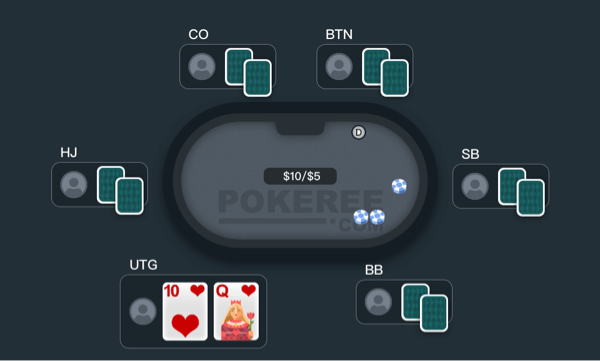
In this case we have QTs (Q = Queen, T = Ten and the ‘s’ after QT means both cards are of the same suit. An ‘o’ after the QT would refer to off-suit) in the first position under the gun (UTG) on a six-handed table with $10/$5 big blind (BB) and small blind (SB). We have to decide what to do: we can raise, call (otherwise known as a limp) or fold. There are a huge amount of factors which we need to take into consideration, however, it is very difficult to cover them all in one article. Pokeree will try to cover the most fundamental factors in the coming paragraphs.
Preflop Poker Strategy #1:
Only play a small percentage of the hands you are dealt
One of the most common mistake new players make is playing too many hands. They believe that they can outplay their opponents post-flop and turn a profit even with the weakest hands. This belief isn’t the case and often is the main reasons a new player loses money when starting out.
Players who play a small selection of the hand they are dealt are referred to as tight. Conversely, players who play lots of hands are known as loose. The vast majority of winning poker players are relatively tight, and for the most part, losing players are loose.
In this case, QTs is in the top 12% of hands (see the push fold chart for more detail) and therefore is a hand we would want to continue with, in this case. So our options are now to raise or to call because our hand is too strong to fold.
Preflop Poker Strategy #2:
Don’t ever limp
Since we decided to raise or to call, another reason new players are unsuccessful just came up: frequent limping.
Limping is defined as calling the big blind instead of raising or folding. For example, you are first to act after you have been dealt two aces (AA) or like our example with QTs and instead of raising, you just call – this is called a limp.
Often, new players limp to see a cheap flop with speculative hands or to trap with strong hands such as AA or KK. Good winning players very rarely limp and there are many reasons why:
1. You give the other players a chance to beat you with their weak holdings. For example, if you limp with AA and your opponent in the big blind checks behind he will have a chance to outdraw you to three of a kind or two-pair. Do not give people a free chance to improve and beat your strong hands.
2. Raising with good hands builds the pot. A big hand deserves a big pot! Typic. ally the only way you will win an opponent’s whole stack (all of their chips) is by raising preflop; winning their entire stack is what you want when you have AA or KK, right?
3. It allows you to better understand what your opponent may have. If we limp in and our opponent is in the big blind, he could have every possible hand; however, when we raise our opponent will fold some of the worse hands and the type of hands he can have become more defined. Experienced players use this to their advantage.
4. Playing speculative hands (hands which could potentially, but infrequently win a big pot) such as 64s (s = suited, o = offsuit) and T2s just is not profitable in the majority of cases, whether you raise or limp, and no matter how good you are at poker.
Let’s go back to our example: QTs under the gun. Since we have to avoid limping, our only option is to raise. But how much? That poses the question of how much? In this case, we will raise to 3x the BB, so $30 and one player calls our bet as shown.
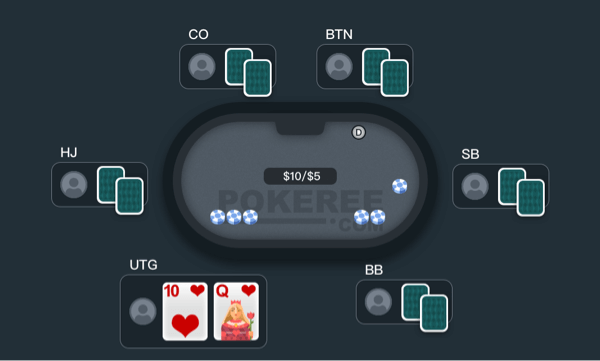
Three times the BB is a standard raise size which we will go into later in this article. But first, here’s another tip you should know: You should only raise or fold your hands when first entering the pot. However, calling with some hands after someone else has raised is fine. There are some situations where open limping is a good idea but they are so few and far between that never limping is a good starting preflop poker strategy - especially for a beginner.
Preflop Poker Strategy #3:
Be aggressive with your strong hands. Bet and raise, don’t ever slow play.
Here comes the next question: how people play poker.
Aggressive vs. Passive
In poker, an aggressive opponent is a player who bets and raises frequently. A passive opponent is a player who calls and checks often and very rarely bets or raises.
In total there are four player styles:
1. Tight-Aggressive (TAG) – This player type which makes up the majority of the winning player pool. They wait for strong hands and bet and raise them hard, punishing other players who play weaker styles.
2. Loose-Aggressive (LAG) – successful loose aggressive players are few and far between. They play lots of hands and play them very aggressively. It is a tough style to play but also a tough style to combat!
3. Tight-Passive (TP) – this player type does not play very many hands and when they do the play them by calling and checking frequently. These players lose their money slowly but surely.
4. Loose-Passive (LP) – these player types just don’t like to fold. Loose passive players play lots of hands – sometimes over 50% of the hands they are dealt. They are the complete opposite of tight-aggressive. This player type is the biggest loser and where the big winners make their money.
Having a strong hand is something that doesn't happen very often so when it does, we need to take advantage of it by putting as much money as possible in the middle to extract as much value as we can.
If our opponent also has a strong hand then we will extract the maximum value by making the pot as big as possible. At the same time, if he doesn't have anything and he folds, then we can forget about the hand and simply move on to the next one.
The last thing you want to do is failed to bet a strong hand. Aggression is one of the keys to success in poker for one simple reason: When you bet or raise, you have two ways to win the pot - either your opponent folds or you get to showdown with the best hand.
Unfortunately, when a player is passive there is only one way to win the pot - by having the best hand. This difference is hugely important and is the reason all big winners are aggressive poker players; while most losing poker players are quite passive.
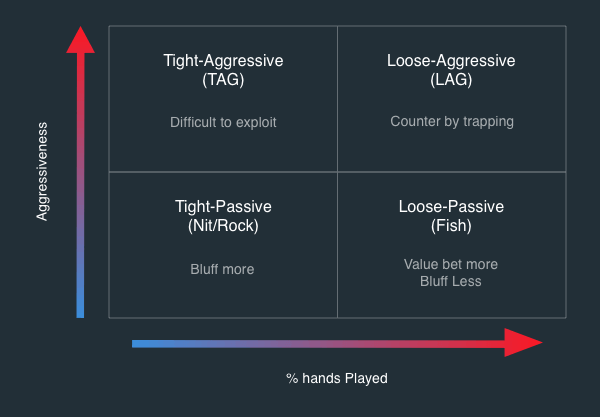
Preflop Poker Strategy #4:
Evaluate the strength of the hand from the rank of the two hole cards.
Here is the chart to help you evaluate your starting hands:
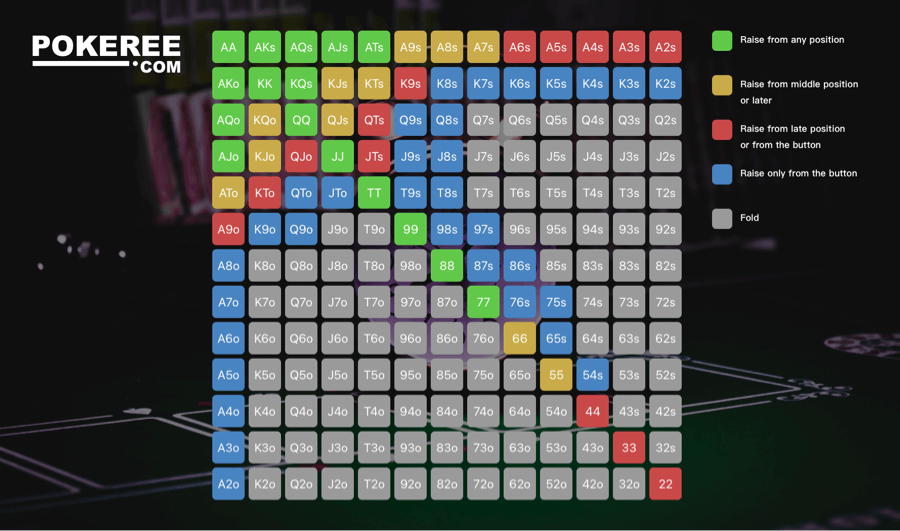
Tip: Suited hands derive their strength from being able to make flushes. However, do not overestimate the value of suited hands. Don’t play a hand just because it is suited. The value of a hand is derived from the combination of the ranks of the two hole cards. Example: AQ is much stronger than Q5, AQ is still much stronger than Q5 suited.
Preflop Poker Strategy #5:
Be aware of your position.
Your position in the hand is an incredibly important variable that you should be aware of in every hand, yet it is something that is all too often forgotten about.
The dynamics of play are slightly different in the preflop betting round, as the small and big blind will be last to act, whereas they will be the first to act on every other betting round. However, the general principles of position will remain the same, as you want to try and play more hands where you have position over your opponents than in positions where you do not.
This means that you should avoid playing too many hands in the blinds or in an early position, as being one of the first to act in each hand can make things very difficult unless you are holding a premium hand. Be very careful when playing in the blinds, and don’t feel as though you have to enter more pots in these positions because you have already committed money to the pot. It is far safer to let marginal hands go rather than to call raises with half a holding and play out of position for the rest of the hand.
Your position can often play a more influential role than the strength of the cards that players are actually holding, so try and keeping the upper hand by combining good position with good cards.
Summary Of Preflop Texas Holdem Strategy
1. Only play a small percentage of the hands you are dealt
2. Don’t ever limp
3. Be aggressive with your strong hands. Bet and raise, don’t ever slow play
4. Evaluate the strength of the hand from the rank of the two hole cards
5. Be aware of your position.
Post-flop Poker Strategy
Once you understand right preflop Texas Holdem strategy, the postflop poker strategy becomes significantly easier. When you play weak hands from poor positions poker is quite difficult; nobody likes to play Q7 from out of position (Out of position means you act first, so your opponent will have more information than you)!
Postflop, there are many factors which we must take into account before we make a decision. The number of variables makes each decision quite complicated for a beginner. However, there are a few guidelines and concepts which can be understood which will help you in the decision-making process.
Postflop Poker Strategy #1:
Always consider what your opponent could be holding.
We should be considering what our opponent may be holding. Does our opponent have only strong hands if he is a tight player? Does he play lots of hands meaning his ‘range’ of hands will be quite weak? It is important as a new player to begin thinking about what your opponent may have. Do not only consider the hand you are holding.
Postflop Poker Strategy #2:
The more players that see the flop, turn, and river the less likely you are to win a showdown with a weak holding such as one pair.
Another consideration is how many players made it to the flop. If the flop is heads up (only you and your opponent) the strength of each hand is much better than if five or even six people made it to the flop. The more players that see the flop, turn, and river the less likely you are to win a showdown with a weak holding such as one pair.
Postflop Poker Strategy #3:
The dryer a board texture, the more likely we are to win the pot by continuation betting (CBet)
The term “board texture” refers to how the community cards interact with typical hand ranges. It is the starting point of postflop strategy after hand ranges have been clearly defined by the preflop action.
Dry board textures are ones which the players in the hand are less likely to have connected with the community cards. Also, dry also means a board which the strength of your holding is unlikely to change over the course of the hand.
Here are two examples of dry board textures:
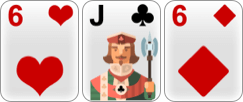
Why are these boards considered dry? Well on the Jc 6h 6d board there are not many hands that will change the strength of your opponent’s or your holdings. If for example, you held QJ, then the only way your opponent can now beat you is if he has:
- An Ax (e.g. Ace-Queen or Ace-Seven) hand and hits an ace on the turn or river.
- A pocket pair such as 77 which hits his set on the turn or river (unlikely).
- A hand such as KQ which hits a runner-runner straight (two cards in a row – for example, the turn is a Ten, and the river is an Ace resulting a straight Ten to Ace) or runner runner full house (two Queens or two Kings).
The most important factor is that neither of these two board has many straight-draw or flush-draw possibilities. The lack of draws means that if you have a hand like A6 on the J66 board or 66 on the 368 board you are very unlikely to be beaten by your opponent if he is behind on the flop.
Additionally, dry flops are inherently difficult to hit and hence makes continuation betting as the pre-flop raiser (you raised first, and someone called your raise) especially useful on dry boards.
A wet board texture offers many different ways to connect with both made hands and draws. Examples are flops such as Js 8s 6d, Kd Jd 9s, and Th 9c Qh. These textures hit many different hand ranges and make postflop strategy more interesting and difficult. The increased connectivity of the board dramatically increases how often a player will flop hands such as two pair and made straights. A hand such as top pair is vulnerable in this situation.

Looking at the Th 9c Qh board, there are many cards which will modify the strength of many hands. If we have AQ or TT on this board we have a strong hand; but on many turn cards such as a K, J, 8 or any heart, the strength of these hands will significantly degrade. Also, there are many hand types that your opponent may have hit this board with:
- Any 8 or K is an inside straight draw (4 cards will complete the straight).
- Any J is an open-ended straight draw (8 cards will make a straight)
The majority of opponents plays Queens, Tens, and Nines.
Therefore, your opponent is likely to continue with a large proportion of his hands on this board.
1. A continuation bet (CBet), as its name suggests, is when you follow up on your previous aggressive action with another bet.
Here is a quick example of a continuation bet.
1. The action is folded to you preflop.
2. You open raise.
3. Both the small blind and the big blind call your raise.
4. This makes your raise the final aggressive action.
5. When the flop comes down, both of your opponents check to you and you make a bet regardless of if you connected with the board.
6. This bet is a continuation bet. You are continuing your aggression from the previous street.
Continuation bets are extremely useful postflop poker strategy for two reasons:
1. It is tough to connect with most board types; therefore player who bets first will often win the pot
2. The player who last raised pre-flop will typically have the strongest hands; thus will get the benefit of the doubt when he bets again.
Postflop Poker Strategy #4:
The greater your stack depth, the stronger a holding you need to stack off.
‘Stack depth’ is the number of chips you have bought in for or currently have on the poker table.
If you are playing ‘short stack’ poker, it means you are not playing with very many chips on the table – for example, 40bb. We do not recommend shallow stack play. Shallow stack poker means we have fewer chips on the table and hence we can win fewer chips from the weak poker players at the table.
Conversely, deep-stacked play means you have a lot of chips at the table – e.g. 200bb deep.
The shallower your stack depth, the more likely you should be to go all in. In poker terms going all-in is called ‘stacking off.'
There are some simple principles:
1. Don't try to bluff a small stack. If your opponent is down to some 10 or fewer BBs and has called to see the flop, he's unlikely to dump his hand to an all-in - unless he missed everything and then he'll dump it to a lesser bet anyway.
2. Similarly, be restrained with big stacks. They're feeling pretty good about life and will look you up with less than they might under other circumstances.
Some hands gain in value when facing a big stack such as small pairs and gutshot draws. When you hit one of these your hand is usually well disguised. Conversely, these hands lose value when facing small stacks.
Before playing a hand pre-flop, you should be checking the stack depth of you and your opponents. Checking stack depth ensures you understand how many chips are at play.
One mistake often made by new players is not considering effective stack size: if you have 100bb and your opponent has 40bb then the effective stack size is 40bb; this is because your opponent can win no more than 40bb from you. Hence your effective stack size can vary from hand to hand, and you must adjust your post-flop poker strategy accordingly.
Summary Of Postflop Texas Holdem Strategy
1. Always consider what your opponent could be holding.
2. The more players in the hand, the less likely you are to win.
3. The dryer a board texture, the more likely we are to win the pot by continuation betting (CBet)
4. The greater your stack depth, the stronger a holding you need to stack off.
Texas Holdem Strategy: Betting and Raising
Poker Betting Strategy Tip #1:
Always consider when betting, will your bet either get your opponent to fold a better hand (bluffing) or call with a worse hand (value betting).
It's all well and good knowing when to bet and raise, but if you don't know how much money you should be betting and raising when the action is on you, then there is a pretty big hole in your game.
There are three reasons why one would want to bet:
1. For value – to get worse hands to call meaning we will win a bigger pot. For example, you value bet AK on an Ace high board (such as A72) to get AQ, AJ, etc. and worse pairs to call.
2. As a bluff – to get better hands to fold so we can win the pot with a poor holding. For example, you may be QJ on the A72 board to get hands such as non-paired Kings (KQ, KJ) to fold.
3. As a semi-bluff – A semi-bluff is much like a natural bluff only that when we are called we will still have a good likelihood of winning the pot. With a semi-bluff, we have a lot of pot equity. An example of a semi-bluff would be betting or raising with a flush draw: a weak non-made hand which has the potential to make a robust hand. See more information on semi-bluffing.
This concept can difficult to grasp as a new player. But generally, you should be just betting with your strong hands; and if you are playing small stakes or especially free poker, keep bluffing to a minimum. People at low stakes or even play money poker do not fold; thus bluffing at these stakes is a complete waste of money.
Here is an example:
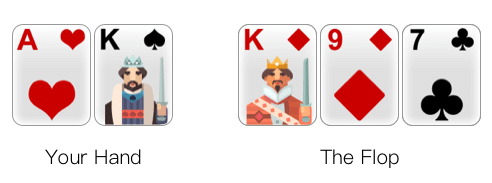
If you bet too little, you are giving players with drawing hands or hands like middle pair the opportunity to see a cheap turn card, which makes it mathematically correct for them to call to try and beat your hand (as they will have good pot odds - but don't worry about this if you are not familiar with pot odds (playing flush and straight draws) yet, just take it as betting too little is bad). So by not betting enough, you are simply allowing other players to catch up and take the pot away from you.
If you bet too much, you are risking a lot of money for the times when an opponent has a better hand than you. Top pair is a good hand on the flop, and a big bet will get rid of those weaker hands that are trying to outdraw you, but what happens if another player already has you beat? You will have committed a lot of money to the pot when a smaller bet would have done the same job but saved you money.
Poker Betting Strategy #2:
The size of your bets should always be made relative to the size of the pot.
This just means that whenever you make a bet, you take into consideration the size of the pot and bet according to how big or small the pot is. But again, this is all well and good, but it doesn't tell you how big your bets should be. So let me give you one more magical rule that you should always try and follow when it comes to bet sizing.
If you have a strong hand that you wish to bet with, you should make your bets between 75% - 100% of the size of the pot.
By following this rule, you will always be able to work out the optimum range of bet sizes to make at any stage of any hand. By betting between these two figures, you will be betting enough to force opponents on a draw to fold, but not risking so much that it makes it detrimental if one of the other players at the table has you beat.










